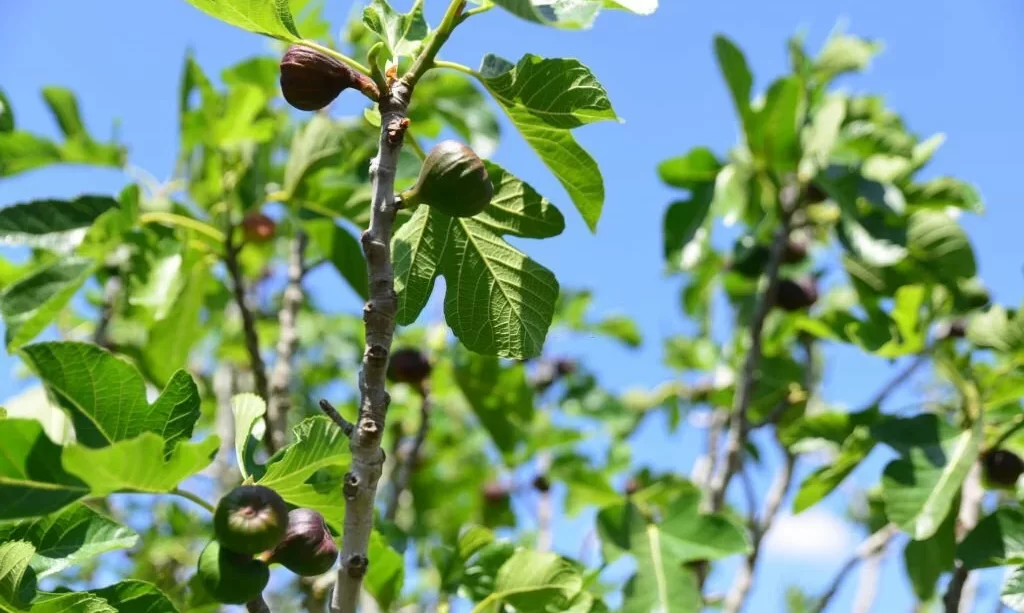Growing a fig tree from a cutting is a rewarding and cost-effective way to expand your garden with a delicious fruit-bearing tree. Fig trees, known for their sweet and succulent fruits, can be easily propagated using this method. In this step-by-step guide, we’ll walk you through the process of taking a fig cutting and nurturing it into a thriving fig tree. Whether you’re a seasoned gardener or just starting your horticultural journey, propagating a fig tree from a cutting can be a fulfilling and educational experience that will soon yield a bountiful harvest.
- Fruit Tree
- 4 Rooted Fig Chicago Hardy plants
- Starter live plants
Gathering Materials
Before you begin the process of growing a fig tree from a cutting, you’ll need to gather a few essential materials. These include:
- Fig Cutting: The key ingredient for this method is a healthy fig tree cutting. Ensure it’s about 8-10 inches long and has several leaves.
- Cutting Tools: You’ll need a clean, sharp pair of pruning shears or garden scissors to make precise cuts.
- Potting Mix: Opt for a well-draining potting mix suitable for container gardening.
- Container: A small container or pot with drainage holes is necessary for planting the cutting.
- Rooting Hormone: Rooting hormone, available at garden centers, will enhance root development.
- Plastic Bag or Dome: A clear plastic bag or a plastic dome can create a mini-greenhouse effect to maintain humidity around the cutting.
Selecting the Right Fig Cutting
Choosing the right fig cutting is a critical first step in the propagation process. Here are some considerations:
- Size: Select a cutting that’s about 8-10 inches long. This size strikes a balance between having enough leaves for photosynthesis and being manageable for planting.
- Health: Ensure the cutting comes from a healthy fig tree. Avoid any cuttings with signs of disease, damage, or pest infestations.
- Time of Year: The best time to take cuttings is during the dormant season, typically in late winter or early spring when the tree is not actively growing.
- Mature Branch: Opt for a cutting from a mature branch, as they tend to root more successfully. These branches are thicker and have a better chance of developing into a robust tree.
Selecting the right fig cutting is crucial for the success of your propagation efforts. With the right materials and a well-chosen cutting, you’ll be well on your way to growing your very own fig tree.
Preparing and Cutting the Fig Branch
Once you have your fig cutting and the necessary materials ready, it’s time to prepare and make the cutting:
- Select a Suitable Branch: Examine the fig tree and choose a branch that meets the criteria mentioned earlier. It should be healthy, of the right size, and come from a mature part of the tree.
- Clean Cutting Tools: Make sure your cutting tools are clean and sharp. Cleanliness prevents the introduction of diseases, and sharp tools ensure clean cuts that are less stressful to the plant.
- Precise Cuts: Cut the branch at an angle, just below a leaf node or bud. Aim for a clean, slanting cut to expose more surface area for root development.
- Remove Excess Leaves: Trim away excess leaves from the cutting, leaving only a few at the top. This reduces the demand on the cutting while it establishes roots.
- Optional Scoring: Some gardeners choose to lightly score or make a small vertical cut on the lower end of the cutting. This can encourage root development but is optional.
Rooting Hormone and Planting
The next steps involve applying rooting hormone and planting the fig cutting:
- Rooting Hormone Application: Dip the freshly cut end of the fig cutting into rooting hormone powder. This hormone encourages root growth and increases the chances of successful propagation.
- Planting in Potting Mix: Place the cutting into a small container filled with well-draining potting mix. Make a hole in the soil using a stick or pencil to avoid rubbing off the rooting hormone.
- Plant at an Angle: Insert the cutting into the soil at a slight angle, burying at least one leaf node. This node is where the roots will develop. Ensure the remaining leaves are above the soil.
- Press Soil Firmly: Gently press the soil around the cutting to ensure good contact between the cutting and the soil. Water the cutting thoroughly.
- Create a Mini Greenhouse: To maintain humidity and create a conducive environment for root development, cover the container with a clear plastic bag or a plastic dome. This will act like a mini-greenhouse.
By applying rooting hormone and planting the cutting correctly, you’ve set the stage for root development and the growth of a new fig tree. The mini-greenhouse created with the plastic covering helps create a controlled environment that mimics natural conditions for root development. Now, patience and proper care will be key to the success of your propagation efforts.
- Clonex is a high performance, water-based, rooting compound
- Contains a full spectrum of mineral nutrients and trace elements to nourish young roots during their formative stages
- Supplies hormones to promote root cell development
- Provides vitamins to protect delicate, new root tissue
- Ensures root production on cuttings of plants
Caring for Fig Cuttings
After planting your fig cutting, providing proper care is essential to encourage healthy root development:
- Location and Light: Place the container in a location with bright, indirect sunlight. Avoid exposing the cutting to harsh, direct sunlight, which can stress it. A sunny windowsill or a spot with dappled sunlight is ideal.
- Temperature and Humidity: Maintain a consistent room temperature between 70-75°F (21-24°C) to encourage root growth. To boost humidity around the cutting, mist the inside of the plastic covering or dome regularly.
- Watering: Keep the potting mix consistently moist but not waterlogged. Use a spray bottle to lightly mist the soil if it begins to dry out. Avoid overwatering, which can lead to rot.
- Monitor for Growth: Check the cutting regularly for signs of growth, which may include the appearance of new leaves or roots. Be patient; it can take several weeks to several months for roots to develop.
- Fertilization: Avoid fertilizing the cutting until it has developed a robust root system, which usually takes several months. Fertilization is typically not necessary during the early stages of propagation.
Transplanting the Fig Cutting
Once your fig cutting has developed strong roots and established itself, it’s time to consider transplanting it to its permanent location:
- Root Check: Gently lift the cutting from the container, taking care not to damage the roots. Examine the root system to ensure it’s well-developed and healthy.
- Select the Planting Location: Choose a sunny spot in your garden or a larger container for the fig tree. Fig trees thrive in full sun and well-draining soil.
- Prepare the Planting Hole: Dig a hole in the selected location that is deep and wide enough to accommodate the root system of the fig cutting.
- Transplant Carefully: Carefully transplant the fig cutting into the prepared hole, ensuring the top of the root ball is level with the soil surface.
- Water and Mulch: Water the transplanted cutting thoroughly, and apply a layer of mulch around the base to conserve moisture and suppress weeds.
- Pruning: Prune back the top growth of the fig cutting to reduce water loss through transpiration. This will help the cutting establish its roots more effectively.
Transplanting your fig cutting to its permanent location marks a significant milestone in your propagation journey. With continued care and attention, your fig tree will continue to grow and, in time, reward you with delicious figs. It’s important to maintain regular watering and monitor the tree’s growth to ensure it flourishes in its new environment.
Fig Tree Care and Maintenance
As your fig tree matures, ongoing care and maintenance are crucial for a bountiful harvest. Here are some essential care tips:
- Pruning: Pruning your fig tree in late winter or early spring helps shape it and encourages new growth. Remove dead or diseased branches and maintain an open canopy.
- Watering: Fig trees prefer consistent moisture. Water deeply when the soil is dry, especially during hot and dry periods. Mulching helps retain soil moisture.
- Fertilization: Fertilize the tree in the spring with a balanced, slow-release fertilizer. Too much nitrogen can lead to excessive foliage growth at the expense of fruit production.
- Protection from Frost: If you live in a region with cold winters, protect your fig tree from frost by covering it with burlap or blankets during freezing nights.
- Pest and Disease Management: Keep an eye out for common pests like aphids and scale insects. Early intervention can prevent infestations. Also, be vigilant for signs of disease, and promptly address any issues.
Troubleshooting Common Issues
While fig trees are generally hardy, they can face some common challenges:
- Fruit Drop: Excessive fruit drop can occur due to various factors, including inadequate pollination, drought, or disease. Ensure proper watering and pollination to mitigate this issue.
- Fungal Diseases: Fig trees can be susceptible to fungal diseases. Avoid overwatering, and maintain good air circulation to reduce the risk of diseases like fig rust.
- Birds and Wildlife: Birds and wildlife may be attracted to your figs. Consider using netting or other protective measures to safeguard your harvest.
- Inadequate Sunlight: Fig trees require plenty of sunlight for fruit production. If your tree isn’t bearing fruit, evaluate its sun exposure and consider relocating it if necessary.
Conclusion
Growing a fig tree from a cutting is a satisfying endeavor that allows you to enjoy the delectable fruits of your labor. While the process requires patience and care, the rewards are well worth it. Whether you’re adding to your existing garden or starting a new one, the ability to propagate fig trees from cuttings empowers you to create a fruitful and beautiful landscape.
As your fig tree grows and matures, remember that it will reward you with delicious figs for years to come. With proper care, attention to detail, and troubleshooting when needed, your fig tree will thrive, enhancing your garden and providing you with a delightful harvest of figs to enjoy.





